Tips from the Army
How to float a jeep? Floating a jeep? Why the heck would you want to float a jeep? Well, if there are no bridges it might be the only way to cross.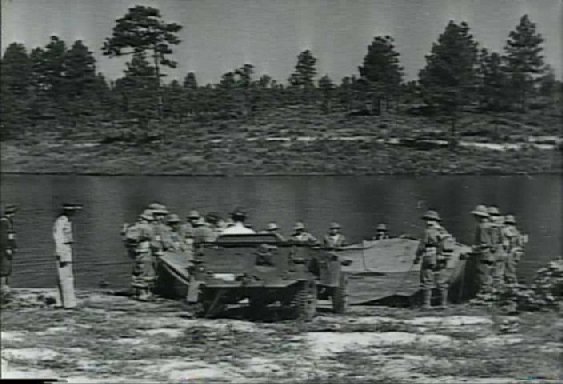 What do you need? Right now no information is available to give exact specifications. However, studying the picture above, I would estimate that you need a tarp approximately 22 feet long and 15 feet wide. Those of you with micrometers and sliderules can take the known size of the jeep and compare it to the picture and use that information to “measure” the tarp in the picture. I have heard or read somewhere that it would be a tarp from a 2 1/2-ton truck.
What do you need? Right now no information is available to give exact specifications. However, studying the picture above, I would estimate that you need a tarp approximately 22 feet long and 15 feet wide. Those of you with micrometers and sliderules can take the known size of the jeep and compare it to the picture and use that information to “measure” the tarp in the picture. I have heard or read somewhere that it would be a tarp from a 2 1/2-ton truck.
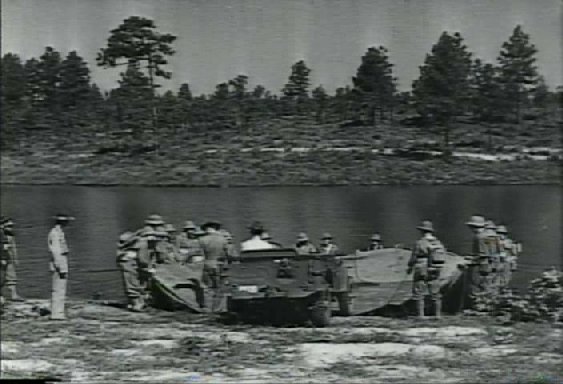 Merely lay the tarp at the edge of the water to be crossed. Have a number of soldiers hold up the sides and the front of the tarp. The Lieutenant drives the jeep onto the tarp.
Merely lay the tarp at the edge of the water to be crossed. Have a number of soldiers hold up the sides and the front of the tarp. The Lieutenant drives the jeep onto the tarp.
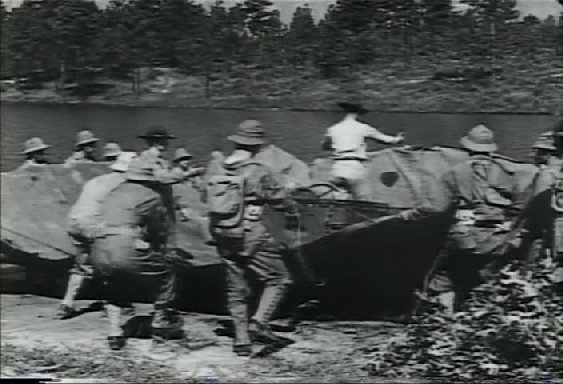 Have your soldiers begin to draw up the sides, folding the material so as to make a seal.
Have your soldiers begin to draw up the sides, folding the material so as to make a seal. 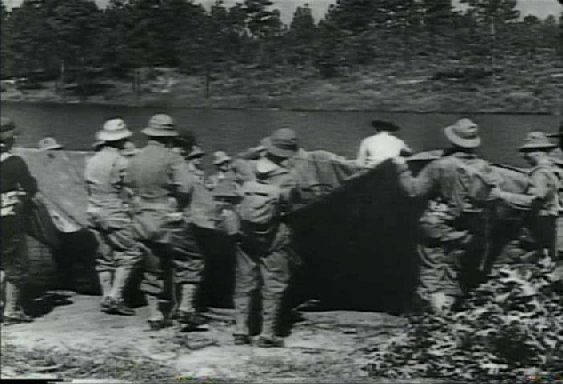 The idea is to form a box around the jeep. The canvas tarp is a water proofed material that allows the jeep a certain amount of bouyancy. Draw it up snug and secure it to the jeep. Once secure use GI grunt power to set it afloat.
The idea is to form a box around the jeep. The canvas tarp is a water proofed material that allows the jeep a certain amount of bouyancy. Draw it up snug and secure it to the jeep. Once secure use GI grunt power to set it afloat.
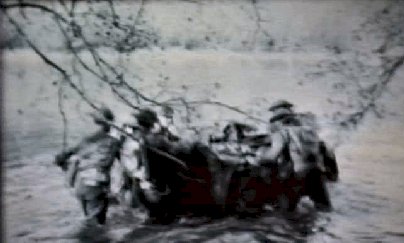
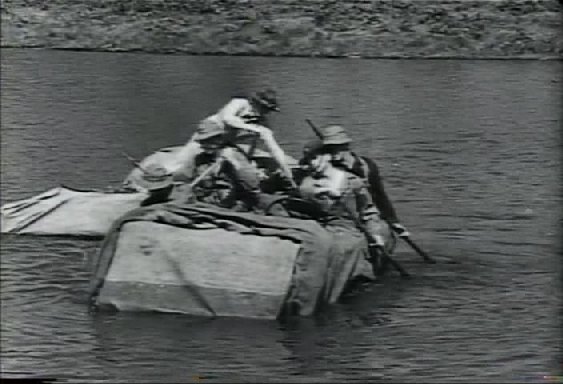 There you have it a floating jeep! Now have your soldiers uses paddles across the stream while the Lieutenant inspects for leaks and double checks those hospital corners. No demerits this trip.
From Nothing but Jeeps – DVD
There you have it a floating jeep! Now have your soldiers uses paddles across the stream while the Lieutenant inspects for leaks and double checks those hospital corners. No demerits this trip.
From Nothing but Jeeps – DVD
Tips from Army Motors
There is a wealth of information available in the original WW2 Army Motors published by the Technical Service Division, Holabird Quartermaster Motor Base, Baltimore, MD
Coating Canvas It’ll warm the cockles of your heart to hear that there’s a piece of equipment on motor vehicles that doesn’t require any more attention than an easy cleaning now and then.
The equipment is the tarpaulin on your trucks and the reason it won’t bother you is the revolutionary new compound it’s been coated with.
The new coating compound goes under the moniker of “CCC—D–746” or “OQMG-3”– but you can call it Mike. Technically speaking, the coating which is made like a paint, consists of penetrating type resins combined with paint pigments and plasticizers; it produces a uniform olive-drab color, and doesn’t gloss up when rubbed.
It’s colorfast (it’s not a dye), weatherfast, fire—resistant, waterproof, to a large extent mildew-resistant and lengthens the life of the canvas. The tarpaulins always remain somewhat “tacky”-—that is, the treatment contains no oxidizing or drying oils which might make the canvas brittle. Dry, brittle canvas wears and breaks easily– the new coating keeps canvas flexible and juicy.
So you see, you don’t have to worry about refinishing or re-dyeing your tarps. They’re good for at least five years before you have to worry about refinishing or re-dyeing (and that is a conservative estimate–we saw some that was tested down in the tropics for five years and they’re almost as good as new).
It’s a far cry from the old days dyed canvas that lost its color and wasn’t waterproof or anything-else-proof. Or from the days up to 1940 when the wax type of treatment was used on canvas. This latter treatment consisted of pigments suspended in waxes and oils. The sun softened it up, brought it to the surface of the canvas and destroyed its waterproof and colorfast properties. As a mater of fact, did you know that an investigation in 1939 showed tarpaulins to be the largest replacement item on motor vehicles.?
Some of you maybe thinking of the canvas tops of reconnaissance cars. These after only a few months in service, bleach out like a fifty-cent shirt, and lose all camouflage value. They are a cinch to guide enemy aircraft directly to the car carrying the officers.
Sgt. Daniel S. Warner, Ft. Rodman, Mass., thought about this for a while and said why not requisition some of this new coating compound and put it on the command car tops. The stuff can be bought loose.
The Chem. Lab. at Holabird was dubious. The canvas of the command car top is “sport cloth”–consisting of a thin layer of rubber sandwiched in between two thin layers of canvas. (Necessary because ordinary canvas shrinks too much for use with the grommet fasteners of the command car.) The thought was that the solvent in the new coating would sink in through the layer off rubber.
Which was the way vehicle manufacturers figured.
However, under test, the new coating was found to have little or no effect on the sport cloth. Proving Sgt. Warner right as rain.
Holabird will immediately advise that organizations in the field requisition the new coating compound and spray or brush it on their command car tops. The coating is also good for tents, leggings–but because of its permanent tackiness, not for canvas vehicle seats. A drier type is being used on canvas seats.
Now, in closing, a word about that easy cleaning mentioned above. Don’t use gasoline or any other solvent on the duck–it may dissolve the coating. Just use a dry brush or a hose and wet brush.
This is one time you don’t have to know yourself out taking care.
From the January 1942, Army Motors
It’ll warm the cockles of your heart to hear that there’s a piece of equipment on motor vehicles that doesn’t require any more attention than an easy cleaning now and then.
The equipment is the tarpaulin on your trucks and the reason it won’t bother you is the revolutionary new compound it’s been coated with.
The new coating compound goes under the moniker of “CCC—D–746” or “OQMG-3”– but you can call it Mike. Technically speaking, the coating which is made like a paint, consists of penetrating type resins combined with paint pigments and plasticizers; it produces a uniform olive-drab color, and doesn’t gloss up when rubbed.
It’s colorfast (it’s not a dye), weatherfast, fire—resistant, waterproof, to a large extent mildew-resistant and lengthens the life of the canvas. The tarpaulins always remain somewhat “tacky”-—that is, the treatment contains no oxidizing or drying oils which might make the canvas brittle. Dry, brittle canvas wears and breaks easily– the new coating keeps canvas flexible and juicy.
So you see, you don’t have to worry about refinishing or re-dyeing your tarps. They’re good for at least five years before you have to worry about refinishing or re-dyeing (and that is a conservative estimate–we saw some that was tested down in the tropics for five years and they’re almost as good as new).
It’s a far cry from the old days dyed canvas that lost its color and wasn’t waterproof or anything-else-proof. Or from the days up to 1940 when the wax type of treatment was used on canvas. This latter treatment consisted of pigments suspended in waxes and oils. The sun softened it up, brought it to the surface of the canvas and destroyed its waterproof and colorfast properties. As a mater of fact, did you know that an investigation in 1939 showed tarpaulins to be the largest replacement item on motor vehicles.?
Some of you maybe thinking of the canvas tops of reconnaissance cars. These after only a few months in service, bleach out like a fifty-cent shirt, and lose all camouflage value. They are a cinch to guide enemy aircraft directly to the car carrying the officers.
Sgt. Daniel S. Warner, Ft. Rodman, Mass., thought about this for a while and said why not requisition some of this new coating compound and put it on the command car tops. The stuff can be bought loose.
The Chem. Lab. at Holabird was dubious. The canvas of the command car top is “sport cloth”–consisting of a thin layer of rubber sandwiched in between two thin layers of canvas. (Necessary because ordinary canvas shrinks too much for use with the grommet fasteners of the command car.) The thought was that the solvent in the new coating would sink in through the layer off rubber.
Which was the way vehicle manufacturers figured.
However, under test, the new coating was found to have little or no effect on the sport cloth. Proving Sgt. Warner right as rain.
Holabird will immediately advise that organizations in the field requisition the new coating compound and spray or brush it on their command car tops. The coating is also good for tents, leggings–but because of its permanent tackiness, not for canvas vehicle seats. A drier type is being used on canvas seats.
Now, in closing, a word about that easy cleaning mentioned above. Don’t use gasoline or any other solvent on the duck–it may dissolve the coating. Just use a dry brush or a hose and wet brush.
This is one time you don’t have to know yourself out taking care.
From the January 1942, Army Motors
